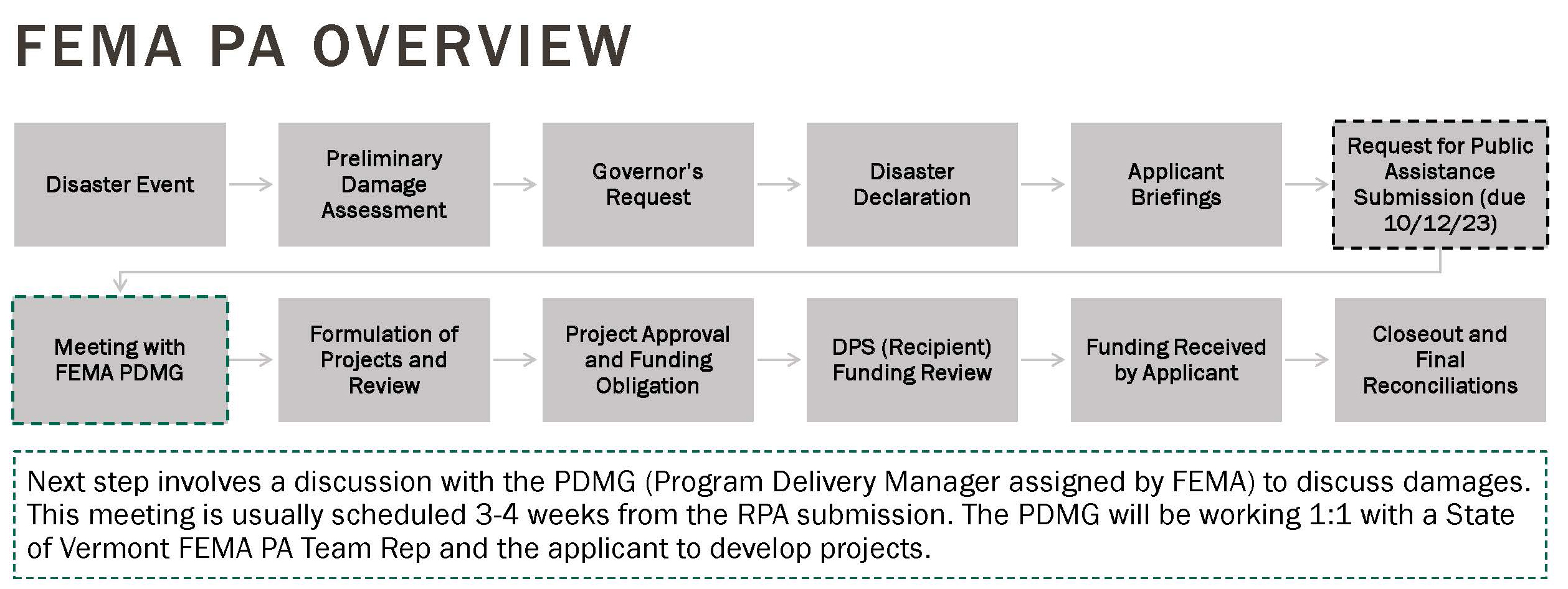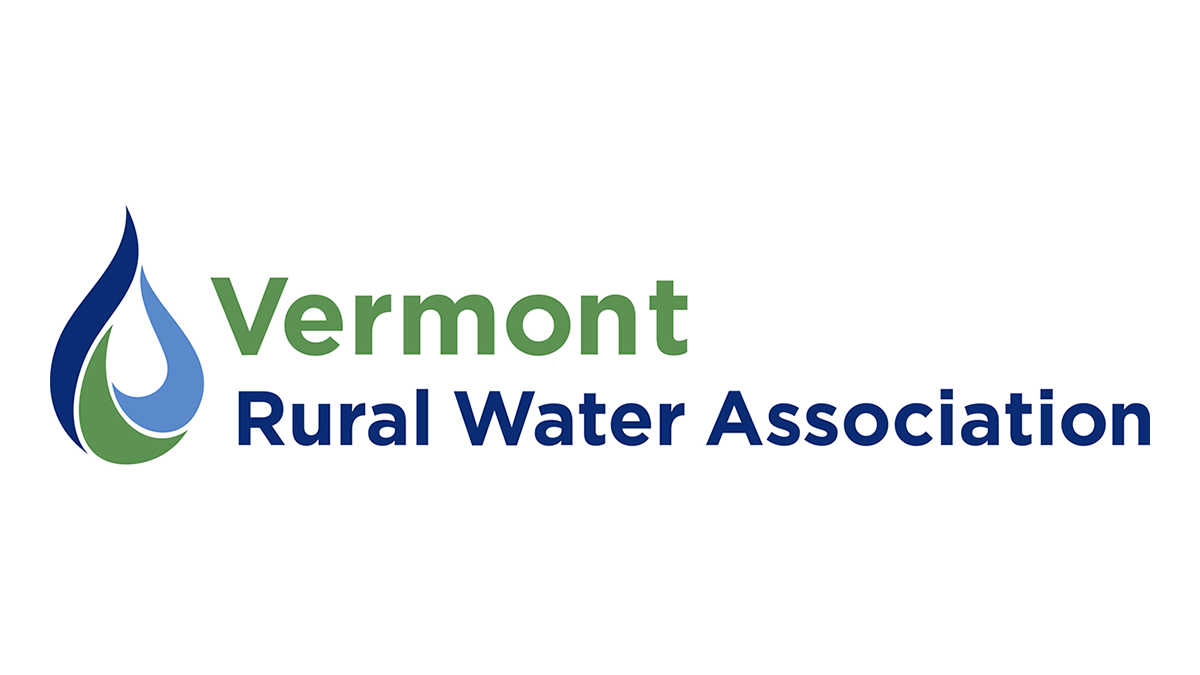FEMA’s Public Assistance Grant Program can help pay for a portion of the cost of the repairing or replacing flood-damaged drinking water and wastewater facilities, as well as hazard mitigation to protect against future disasters. The amount of FEMA and State reimbursement depends on a municipality’s Emergency Relief Assistance Fund rating. Find your municipality’s rating on floodreadyvt.org. Non-governmental entities must pay the full 25% FEMA match. This is a reimbursement program, so applicants pay the cost upfront and then are reimbursed by the State of Vermont using FEMA and State funds.
The program will fund emergency work to restore water/wastewater services immediately after a disaster, permanent work to restore a damaged facility to its pre-disaster design, and hazard mitigation measures to protect against future disasters. The cost of establishing temporary emergency services in the event of a utility shut-down may also be eligible (e.g., providing a temporary sewage facility).
Eligibility
-
- Municipally-owned water and wastewater systems, as well as certain nonprofits, are eligible for FEMA’s Public Assistance Program.
- At least one person from the entity applying must attend an applicant briefing, or watch a recording of the briefing (see below).
- Addison, Bennington, Caledonia, Chittenden, Essex, Lamoille, Orange, Orleans, Rutland, Washington, Windham, and Windsor counties are eligible.
- There is a minimum of $3,800 in damages.
Applicant Briefings
Vermont Emergency Management held applicant briefings on the week of July 31 to discuss how to apply for FEMA’s Public Assistance Program. Any entity applying for the program must attend a briefing or watch a recording in order to be eligible. For municipal applicants, if one person from the municipality attends, all municipal departments are covered. (It may still be beneficial for additional employees to attend if they haven’t been through this process before.)
Request for Public Assistance
For those impacted by the July flooding, a Request for Public Assistance (RPA) must be submitted through FEMA’s grant portal by October 12, 2023.
-
- The grant portal is at https://grantee.fema.gov/
- For municipally owned water and wastewater systems, contact ADM.2023floods@Vermont.gov to ask whether the municipality or water/wastewater system should submit this request.
- Fire districts and qualified nonprofits should submit their own request.
- The disaster code for the July 2023 floods is DR4720-VT
For those in Addison county impacted by the August flooding, a Request for Public Assistance (RPA) must be submitted through FEMA’s grant portal by November 5, 2023. The application process is the same as above, but the disaster code is DR4744.
Next Steps
-
- After you submit a Request for Public Assistance, you will be contacted by a Program Delivery Manager from FEMA who will help with the next steps of your application, including meeting to discuss damages and possibly a site visit.
- You will be given a Damage Inventory Spreadsheet where you will need to record all damages.
- You should continue doing repair work while you are applying for FEMA funds.
- Document the work you have completed and continue to do, as it will be eligible for reimbursement.
- Follow your system’s procurement policy for materials and labor.
- You should still submit claims to your insurance company.

Graphic created by Vermont Emergency Management, used with permission. Click here for a PDF version.
Graphic description: Heading reads “FEMA PA Overview.” Flow chart reads “Disaster Event > Preliminary Damage Assessment > Governor’s Request > Disaster Declaration > Applicant Briefings > Request for Public Assistance Submission (due 10/12/23) > Meeting with FEMA PDMG > Formulation of Projects and Review > Project Approval and Funding Obligation > DPS (Recipient) Funding Review > Funding Received by Applicant > Closeout and Final Reconciliations.” Below is a box that reads, “Next step involves a discussion with the PDMG (Program Delivery Manager assigned by FEMA) to discuss damages. This meeting is usually scheduled 3-4 weeks from the RPA submission. The PDMG will be working 1:1 with a State of Vermont FEMA PA Team Rep and the applicant to develop projects.”
Documentation
Track all expenses, including staff time (both regular and overtime) and equipment use for anything related to disaster response and recovery.
-
- See FEMA’s Schedule of Equipment Rates (2021) for reimbursement rates of equipment that you own.
- Administrative costs related to the FEMA application, documentation of damage, and reporting are eligible for reimbursement, so track this time as well. There is a limit of 5% of eligible Public Assistance costs for administrative costs.
More Information
-
- FEMA’s help desk is 866-337-8448
- Send questions to Vermont Emergency Management at adm.2023floods@vermont.gov
- How to Apply for Public Assistance: https://www.vlct.org/resource/fema-public-assistance-how-apply-0
- FEMA’s page on Public Assistance: https://www.fema.gov/assistance/public
- Vermont Rural Water’s page on flood recovery: https://vtruralwater.org/flooding-july-2023/
- Fact sheet from EPA about Public Assistance for Water/Wastewater Utilities
- Fact sheet from EPA about lessons learned from water/wastewater utilities that participated in FEMA’s Public Assistance Program
Other FEMA Funding
There is over $60 million available in Vermont from FEMA’s Hazard Mitigation Grant Program for projects that reduce the risk of flooding or other hazards. Water and wastewater systems could use this funding for projects like floodproofing, relocating, or elevating infrastructure. Applicants do not need to have damages from last summer’s flooding to be eligible. The State of Vermont will be covering the 25% match.
The pre-application deadline is August 16, 2024. Find more information at https://vem.vermont.gov/disaster-based-funding
Tips from Water & Wastewater Operators on FEMA Applications
We talked to Vermont Rural Water board members John Lazelle (Wilmington WWTP) and Ray Counter (Brandon Fire District #1), whose systems both received FEMA Public Assistance grants after Tropical Storm Irene in 2011. Here is some advice they shared:
-
- Document everything! Record everyone’s hours, both regular hours and overtime hours. Document every expense and every piece of equipment you use. If you used a bucket loader, write down when and where you used it and the hourly rate (see FEMA’s Schedule of Equipment Rates).
-
- Documenting the work you do before the FEMA inspector arrives is most critical, because they won’t see this damage for themselves.
-
- It might have been harder to get photographs of damage that occurred within the community (pump stations, culverts, manholes, etc.) because the volunteer response and cleanup efforts started so quickly after this flood. But the prevalence of smartphones and social media may be a benefit, because volunteers may have taken photos of the damage. Consider reaching out to your community (social media, Front Porch Forum, local newspaper, etc.) if you need photographs from the initial days of flooding to document damage.
-
- The municipality’s insurance covered about 90% of damages, like facilities, equipment, and electrical. FEMA covered some of the things that insurance didn’t cover, like the time that equipment was used and staff labor/overtime.
-
- Insurance will only replace exactly what was damaged, but in some cases FEMA will pay for upgrades and hazard mitigation to prevent damage from future disasters (upsizing culverts, relocating pipes, installing flood doors, etc.). John and Ray both emphasized the importance of taking advantage of this opportunity to make your facility more resilient to future disasters.
-
- Emphasize that anything you were able to repair on your own was “emergency work” and may still need a permanent replacement. Don’t be too optimistic about what you can fix on your own. A temporary fix that is working at the moment might not make it through the winter or the next big storm. Equipment and parts that came in contact with floodwaters may have a reduced life expectancy, even if you were able to get them working again. FEMA will fund permanent replacements in addition to the emergency work you’ve already done.

